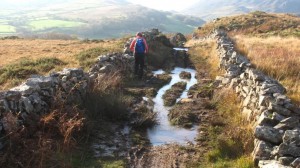Footpaths are neglected national treasures
Hugh Thomson

As the world and its dog prepares to take the traditional Boxing Day hike, it’s a good moment to take stock of one of our most under-rated resources — the nation’s footpaths.
Earlier this year I joined more than 200 people at an outdoor memorial service for the late Tony Drake, held on a blustery hillside in Gloucestershire. It was appropriate that all of us had to walk five miles to get there, for Tony was at the heart of the Ramblers movement.
Almost 90 when he died, he spent much of his life fighting on its behalf.

He created the Cotswold Way, Offa’s Dyke Path and the celebrated Cambrian Way, the hardest of all Britain’s long-distance footpaths. Janet Street-Porter wrote to Tony on finishing it: “The Rhinogs were tough!” Any expletives had presumably been deleted in deference to his advanced age.
Perhaps more importantly, he was a tireless campaigner to open up the countryside. Right up to his death he was arguing that so-called white roads — which appear on the map without any right-of-way access, but are maintained by local authorities — should be made accessible to the people who pay for them: us.
There is an assumption that since the “Right To Roam” Act of 2000 footpaths can look after themselves but the Act only applies to uncultivated areas, such as moorland or hills. When walking from Dorset to Norfolk recently for a book, I came across numerous landowners who still try to deter access. One gamekeeper told me I was trespassing on private land. When I showed him the footpath clearly marked on the OS map, he argued: “Yes, well it might be a footpath I suppose, but not when the pheasants are breeding.”
Any farmer who wants to deter walkers has many ways of doing so, from ploughing up the path to letting signposts get obscured. There’s also that old trick of putting a bull with four cows in a field (a bull is held to be “quiescent” if it has four females to service — but try reminding the bull that when you’re running away).
We forget how lucky we are to have such a 140,000-mile network of national footpaths. A visit to Ireland, where no rights of access exist, let alone to parts of the United States with large signs warning “trespassers will be shot on sight”, is a good reminder of our heritage.
Yet it is a heritage we are complacent about. Natural England, the body that maintains the National Trails among many other responsibilities, has had its funding slashed. Footpaths are seen as a soft target for cuts. The budget to maintain Tony’s 102-mile Cotswold Way has been reduced from £240,000 to £64,000. Bearing in mind that some 300,000 people walk it each year (electronic counters hidden in the bushes count them), this compares poorly to other sports funding.

It’s a pattern that has been repeated right across the country. Seventy per cent of local councils in England have slashed their budget for footpaths. In many places, they have become overgrown and unwalkable as clearance teams are laid off. A recent Ramblers report, Paths in Crisis, used the Freedom of Information Act to force councils to admit to 100,000 reported problems that they haven’t addressed.
We also seem to have lost our ambition to create new paths. It took Tony Drake and his colleagues fifty years before the Cotswold Way was made a National Trail in 2007. Attempts to create the Great Stones Way, running between the prehistoric monuments of Avebury and Stonehenge, have met with opposition from “local stakeholders” despite the obvious tourist benefits that would follow.
.
The Cambrian Way that Janet Street-Porter had problems with is an unofficial path only — perhaps why she found it so difficult. What is badly needed is for the Government to create a National Trails Trust, which can focus exclusively on maintaining and promoting these jewels in the countryside’s crown; and for local councils to recognise the value of walking, still the nation’s favourite form of exercise.
The “Right To Roam” Act was one of the few genuinely popular successes of the previous Labour Government; the coalition needs to ensure it does not undermine that success, or they will have a small army of doughty ramblers, many with dogs, advancing upon them.
.
Hugh Thomson’s The Green Road into the Trees: An Exploration of England is published by Random House
.

I was there that day as well and you can already tell that the budget to maintain the Cotswold Way has been slashed. It’s short sighted and makes little economic sense – we only have to look at the investment in the Welsh coastal Path to see the effect of the walking public on rural economies.